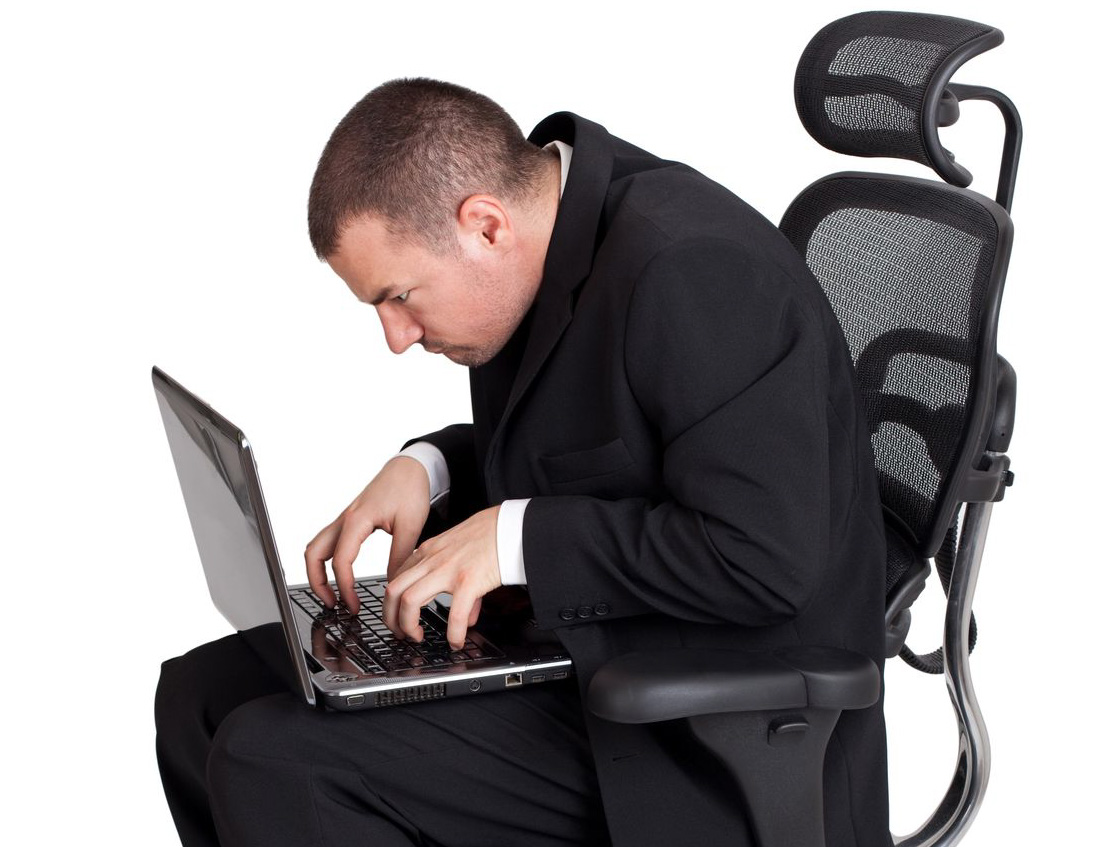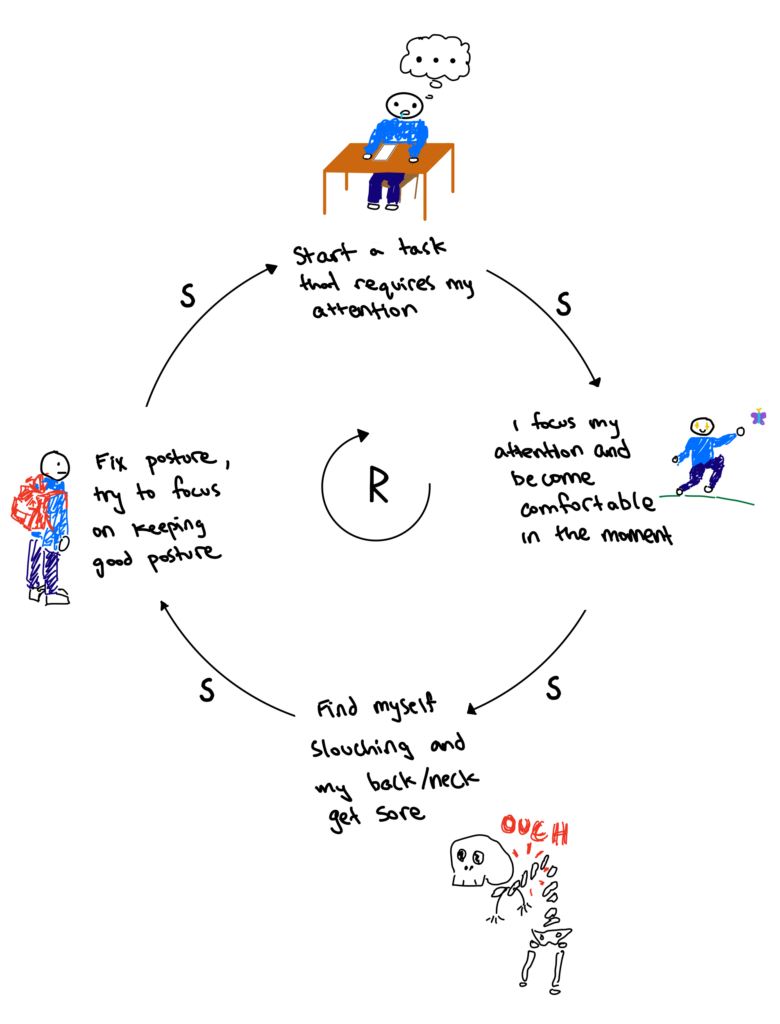The behavior I chose for this assignment is fixing my posture in the hopes that my back/neck will go from looking like this ( to this |. Posture has always been something I have tried to be mindful of, especially due to extracurriculars such as swimming or violin, where it was more important to keep good posture. However, coming to Stanford (and studying CS) means that I am now sitting at a desk or chair on my computer almost 90% of the time, which inevitably leads to me catching myself in a reflection looking like a goblin with my back hunched over. Having good posture is something that I would actively like to change now because I believe it will result in positive health benefits for both the short and long term, and also (ideally) give me another inch or two in height.
In order to accomplish the guidelines for this assignment, I first decided on what constituted “bad” posture. To keep it simple, I decided that this would just mean whenever I find myself with tensed shoulders, a rounded back, or slouched neck (Something that happens a lot when I’m using a computer). Below are some pictures that show this more clearly.


I decided to keep it simple used my Notes app to record whenever bad posture occurred. To make sure I wasn’t missing any instances, I also made a mental note to check myself roughly every 30 minutes. For additional clarity when analyzing the results, I also recorded what I was doing at the moment to see if there were any patterns. If I was doing something over the course of several blocks of time like studying or gaming, I just tallied the amount of times I found myself slouching. The range of time that I recorded begun when I woke up on Sunday 1/14 and ended when I went to bed Monday 1/15.
From the data I collected, I was able to construct the following 2 models (See more detailed log at end of blog post).
The first model I created was a connection circle. Arrows point towards the next step in the sequence:

The second model I created was a reinforcing feedback loop:

Creating these models made me think through the issue of bad posture in a new way. Specifically, it made me realize that many of the factors leading to my slouching and bad posture were things that I had to do multiple times a day. In fact, it wasn’t necessarily that I was forgetting to keep good posture — instead, it seemed like the reason I kept finding myself slouching was that the tasks that I had to fulfill throughout my day took all of my attention, and inadvertently made me lose my posture.
In my connection circle, I listed as nodes the most important factors that I found to contributing to my slouching. In blue, I denote the current state of my posture (Slouching vs. Fixed posture). In green, I have the current state of how I feel. In orange, I have the current state of whether I am comfortable or not at the given moment. Finally, in pink, I have the current action or task I am completing. Some factors that are not listed but ones I found interesting include:
(1) Walking in cold weather –> Trying to bundle myself up –> Hunching shoulders up –> Bad posture
(2) Sitting in a chair with no back rest –> Nowhere to push my back against as I do work –> Slouching
(3) Sitting at a desk where the chair is too high/too low –> Either have to crouch or reach awkwardly –> Bad posture, sore
Prominent patterns I noticed when completing the connection circle had to do with the weird interaction between actions taken when I’m uncomfortable or stressed ultimately leading to me being relaxed and finally slouching. This loop is highlighted in light green. Ultimately, I found that whenever I was doing an action that needed my concentration, whether it was “good” or “bad” (e.g. studying vs. gaming), it made me take my mind off my posture and slouch. Actions that were meant to distract me, like gaming, walking, or even working, were especially strong factors that ended up in my posture breaking. In fact, I slouched nearly 4 times writing this section of the blog post alone because I kept having to shift my attention.
The second model, which showcases a reinforcement loop, further abstracts the findings from my connection circle. Whereas the connection circle focused mostly on specific actions or feelings that led me to slouching, the reinforcement loop shows at a high level what I believe is happening behind the scenes. Starting at the top, first, I start a task that requires my attention. Then, because my attention has been shifted and I have been focused on that task, I get myself in a state where I am comfortable. This leads me to slouching and realizing that my posture isn’t good when my back starts feeling sore. Finally, I fix my posture, promising myself that I’ll really remember this time, and ultimately starting the cycle all over again.
The Measuring Me #2 experience was quite different for me than the first one. This is because while the first one felt more like a daily log where I was just listing what I was doing at the moment, this assignment made me focus specifically on a certain behavior. One of the most significant takeaways for me is that my bad posture may not (only) have to do with me being really bad at holding myself accountable and remembering to do the slouch test every 5 minutes. Instead, it’s the fact that trying to focus on something constantly while other tasks take up your attention throughout the day is exceedingly difficult.
If I were to do this assignment all over again, one change I think would be beneficial is having a second person or outside people also checking my posture. I know that even though this assignment was something I was thinking of throughout the day, there were probably a lot of moments I missed of myself slouching. To get even better data regarding this, I think it would be really interesting if someone just followed me around for a day or two and recorded the start/end times of my slouching to see if there was a pattern for when I realized I was slouching and how long it took me to realize. Finally, if I couldn’t have access to a person willing to tail me for 2 days straight, I would try to find another way to log myself because opening the Notes app every 10 minutes was a bit tedious. Instead, I would want a simple app where I could just click a button to add +1 to my slouch count.
While I’m not going to magically fix my posture or make a queen proud anytime soon, I think I’ve learned some valuable lessons over the past week, which I’ve summarized into 3 big points.
- Keeping something on the back of your mind and sticking to it is hard
- Changing a habit, especially a physical one, is hard
- Finally, convincing yourself that you could grow a couple inches is much better short-term motivation than anything related to health benefits
I hope you have learned as much about this as I have. Thanks for reading all the way through.
–Collin
As promised, here is my detailed account of logged data:
1/14
10:00 – Just woke up, still in bed, posture broke while scrolling through Instagram and sitting up in bed
10:30 – Slouched while using bathroom
10:40 – Sat down to eat a bit of food, slouched while on phone again. Slouch count: 2
11:00 – Driving back to campus, slightly broke posture while looking out window
11:05 – Slouched again without realizing after writing in Notes app 🙁
12:00 – Woke up after nap in car. Was told I wasn’t necessarily slouching but my spine wasn’t fully straight while I slept. Arrived back on campus. (+0.5 slouch count)
12:30 – Eating Chipotle. Slouched while in conversation. Slouch count: 3
1:00 – Slouched while walking from car to room.
1:10 – Back on campus, doing work in room. Slouching while using laptop. Realized that my chair might be too high and lowered it.
6:20 – Finished doing work. Slouch count: 14
7:00 – Preparing dinner. Slouched while sitting in chair waiting for pan to heat up. Scrolling on Instagram.
8:00 – Finished eating dinner. Slouched twice while eating and talking.
8:05 – Starting free time, playing games. Slouched immediately after starting to play
11:00 – Finishing up games. Slouch count: 23. Note: Significantly more difficult to remember to keep good posture when playing games.
11:30 – Getting ready for bed
11:35 – On phone, sitting up in bed. Posture broke after scrolling through TikTok/Instagram
1:00 – About to go to bed. Slouch count: 7
1/15
1:00 – Woke up late. Sitting up in bed scrolling through social media. Slouch count: 2
1:30 – Walking to Arrillaga dining. A little slouched while walking.
2:30 – Finished eating. Slouched while waiting in line for food and while talking with friends. Slouch count: 3
3:00 – Walking over to West campus to find study spots. Cold weather made me hunch over a little. Slouch count: 3
4:00 – Found no open buildings or rooms, drove to a cafe to work. Slouched while going from parking lot to cafe. Begun studying.
7:00 – Working in cafe. Slouch count: 11. Note: Chair had no back and I think it may have contributed to me slouching
7:15 – Walked to dinner near cafe. Broke posture while waiting in line.
8:00 – Finished eating. Slouched 2 times.
8:30 – Returned home. Began finishing up some work.
10:00 – Finished working, switching to games. Slouch count: 15. Note: When I lean in to see something more clearly, I end up slouching back.
12:00 – Finished gaming. Slouch count: 11.
Total slouch count: 110.5. Damn.



